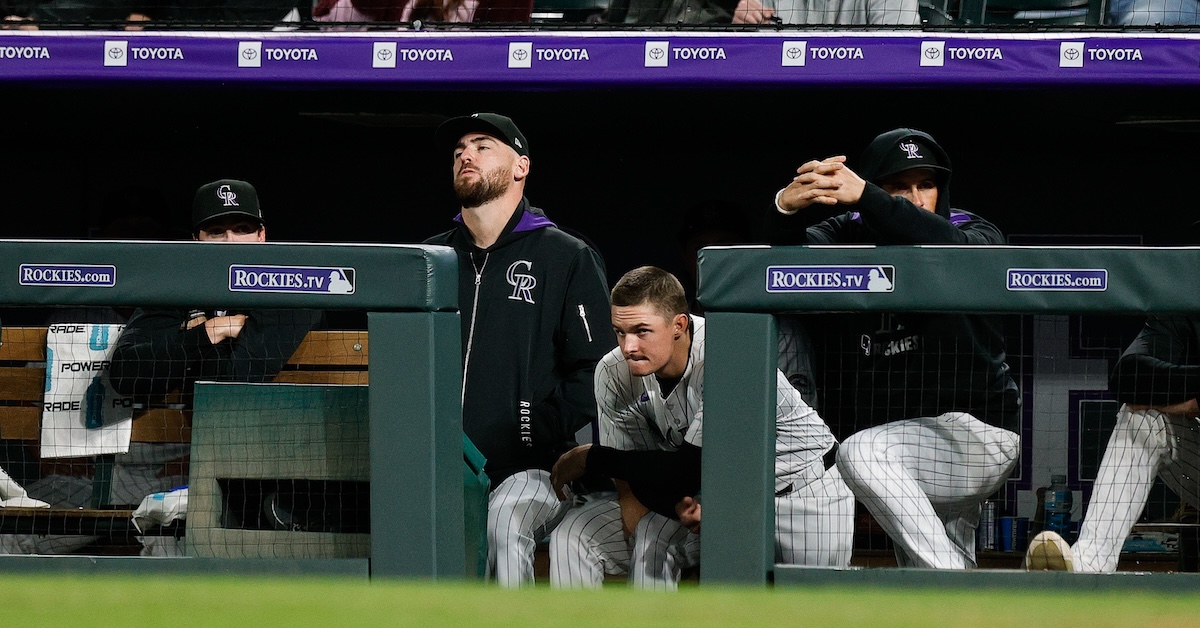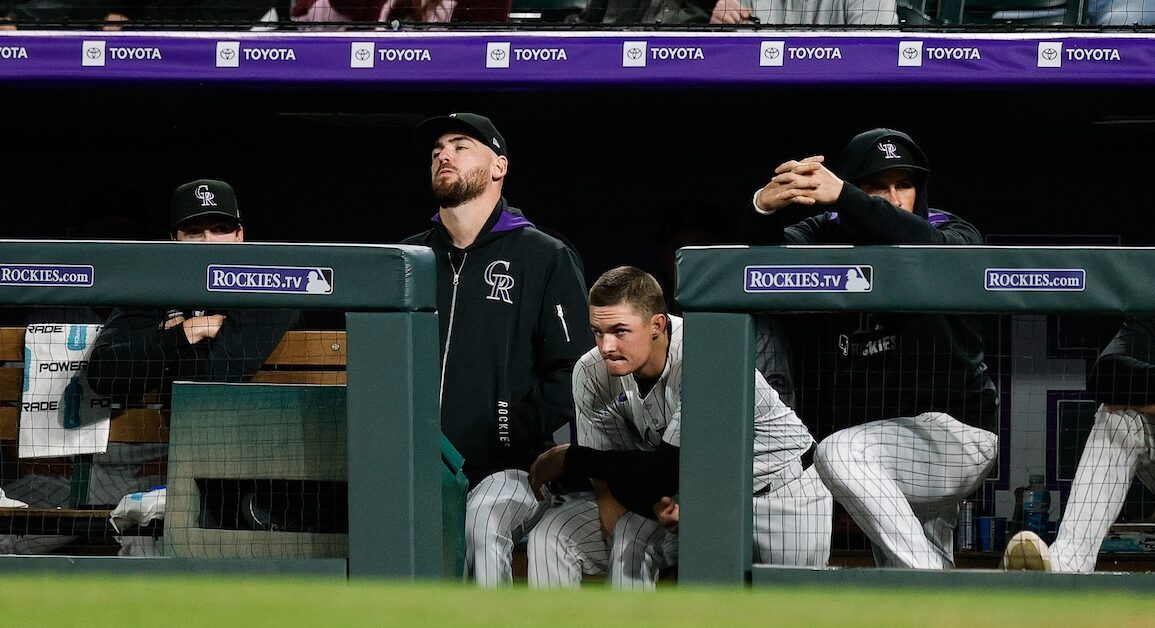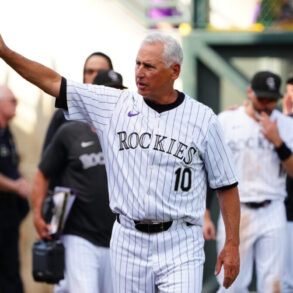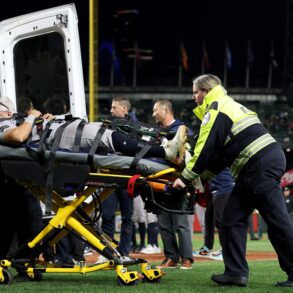The Rockies’ Hard Place

When the Rockies fired Bud Black on Sunday, the immediate reaction — a sarcastic “Oh, sure, that’ll solve everything” — missed… not all the point, but some of the point.
Last year, we watched the Chicago White Sox lose more games than any major league team in history, and if the White Sox hadn’t gotten white hot in the last week of the season, the final number would’ve been much more embarrassing than 121. This year’s Rockies are worse. Maybe a lot worse.
Just two weeks ago, Dan Szymborski busted out the ol’ ZiPS machine for the purpose of finding the likelihood that the 121-loss threshold would be broken once again. The Rockies had a 7.0% chance of at least matching Chicago’s record, and a 5.2% chance of taking it outright.
The Rockies — who, hilariously, chose to fire Black after a rare win — lost 13 of their next 15 after Dan’s article. They’re playing at a 28-win pace, which is obviously unsustainable. To get a clearer picture of how bad things have gotten, I asked Dan to run the numbers again. Before Monday’s games, the Rockies had climbed (or fallen) to a 13.9% chance of at least tying the White Sox, and an 11.6% chance of going 40-122 or worse.
That’s not a fait accompli. Maybe interim manager Warren Schaeffer, in a feat of Churchillian leadership, can light a fire under these violet-clad unfortunates and coach them up into a garden variety 110-loss team. But it’s a sobering figure. If there were an 11.6% chance of bricks falling from the sky, you wouldn’t leave your house without wearing a helmet.
So no, I don’t think Black was the real problem. Black is a perfectly average major league manager. Over his first 14 seasons as a major league manager, Black posted a .482 winning percentage. He’d never won fewer than 71 games, or more than 91, in a full season to that point. Narrow-eyed and silver-haired, Black managed with an air of understated, even dignified restraint. He’s been ejected 38 times in 2,596 games, but I don’t remember him ever bumping an umpire or turning colors while dressing down a player in public, or anything else that might dishonor himself or his uniform.
But the Rockies fired Black because when a team starts 7-33 (7-34 after Monday’s loss against the Rangers), heads have to roll, and there’s an order in which these things get done. I don’t think he’s done anything objectionable, but a big part of the manager’s job comes when that job ends. His is always the first head to roll.
Insofar as there was a problem with Black, it’s this: Mostly I forgot he was there. And so too, it seemed, did management and ownership.
Black’s first two seasons in Colorado were awesome; 2017 and 2018 brought two of the five playoff appearances in franchise history, and two of the four seasons (out of 33) in which the Rockies finished more than two games over .500. But since then, they’ve sucked.
Any manager (at least, any non-Yankees-under-George Steinbrenner manager) would get a pass for going 71-91, as Black’s Rockies did, after two straight playoff appearances. Then came the pandemic year. But if Dick Monfort and his functionaries wanted to throw the manager onto a pyre for poor performance, they had cause to do so as early as 2021. It’s been four years since then, including consecutive 100-loss seasons. Is anyone even home?
The Rockies, it turns out, are famously insular. They like and trust Their Guys, and are loath to turn over personnel or chase the latest innovations. In almost any other industry, that quality would be benign at worst, or even laudable. But baseball is zero-sum. If you’re not advancing, you’re falling behind. And since Black last led the Rockies to the playoffs, the industry-wide rate of innovation has only exploded.
The Rockies are far from the only team that’s chained inescapably to a millstone of an owner. But Monfort’s problem is not that he doesn’t spend. This year’s Rockies are 21st in the league in payroll; every crappy Rockies team since 2019 has cost at least $118 million to field. As recently as 2023, the Rockies ran a $172 million payroll. They’ve locked up their promising homegrown players and dipped into at least the middle tier of free agency with some regularity. They’re not the Mets or Dodgers, but I’d hesitate to call the Rockies a cheap organization.
It’s an irony that borders on tragic, because good players cost a lot. Hiring people who can implement a good process is relatively inexpensive. Jake Mintz of Yahoo just wrote a more extensive blow-by-blow of where the Rockies fall short, but one detail of his reporting stood out: “[S]ources indicated to Yahoo that Monfort — who chaired the owners committee during the 2022 CBA negotiations — is hoping the next CBA contains a salary cap… that extends beyond MLB payroll to cover all organizational spending, including coaching, technology and scouting.”
Seeking a cap of off-field spending would be a cataclysmic error from Monfort, who would merely close off the cheapest and fastest way for his team to return to parity with his rivals. It would only calcify the disadvantage his organization has embraced; if the Rockies and Dodgers could spend the same amount of money across their entire organization, why on Earth would you believe that the Rockies would spend it more wisely?
I don’t think anyone, especially outside the Rockies organization, does.
I think a lot about a conversation I had last year with Jeff Hoffman, a former Colorado pitching prospect now with the Blue Jays, who snarked his former team with a readiness I did not expect from an active player on the record.
I had a similar conversation with Gerrit Cole early in his tenure with the Astros, when he was in the midst of becoming the future Hall of Famer we know now, largely by junking what he learned in Pittsburgh. Cole was cautious and precise, even parsimonious, in his response.
By contrast, here’s Hoffman 13 months ago: “Shoot, in Colorado, we didn’t really have an analytics department. I’m not even sure if they have one right now, judging by how everything’s going there.”
It’s not just Hoffman who talks like that about the Rockies. Everyone talks like that about the Rockies. And every time it happens, I’m astonished that there’s an entire organization — one that made the playoffs not too long ago — that’s not just poor, or cursed, but gets talked about like it’s got toilet paper stuck to its shoe.
Based on both process and results, it’s hard to draw any other conclusion. They’re not totally incompetent; turning defensive wizards Ezequiel Tovar and Brenton Doyle into league-average hitters was a pedagogical triumph. And even in the thin air, they develop the occasional All-Star pitcher.
Unfortunately, every success is watered down by an avalanche of failures. In the past 10 drafts, the Rockies have made 16 first-round picks. Only one, Brendan Rodgers, has a positive career WAR. Only one other Rockies pick in the first three rounds — 41 players in all — is more than a win above replacement for his career: Garrett Hampson, a utilityman and pinch-runner with a career wRC+ of 69 and a WAR of 1.4 in 648 games.
In 2022, fortuned smiled on the Rockies, who had Kris Bryant fall into their lap in free agency. Back in the mid-2010s, everyone was sick of Bryce Harper, Mike Trout mostly kept to himself, and Shohei Ohtani was still in Japan, leaving baseball without a marquee superstar. This was a source of constant discussion, and Bryant — a tall, handsome recent MVP — got brought up as a potential Face of Baseball as much as anyone. In his walk year, Bryant hit .265/.353/.481 while playing five positions regularly; the Rockies’ needs at the time were great, but Bryant could fill any void.
But in three-plus seasons in Colorado, Bryant has been hurt most of the time and sub-replacement level when available. He might as well have been abducted by aliens. He’s become the face of the Rockies organization, but not in the way anyone involved in the signing had hoped.
I could go on.
Obviously, firing the manager doesn’t fix all this. But I don’t know what does. I don’t even know where to start. You could say Monfort ought to sell the team — a fish rots from the head and all — but the one person capable of having the most deleterious effect on a franchise is the one person you can’t fire.
Firing Black only makes sense if it’s the first step — again, there’s an accepted order to such things — in a complete organizational overhaul. Not just a rebuild, or a tank, or a reset. If the Rockies sell off their veterans now, they won’t get much in the teardown, and it won’t matter anyway, because their prospects won’t develop. Unless they completely change the way they operate in order to catch up to the other 29 teams, a rebuild would only reproduce the same results.
It’s not an easy thing to contemplate, the beginning of a rebuild during what will surely be the third straight 100-loss season. It’ll take time to tear the Rockies down to the studs. But the studs themselves could be worse. They have a great ballpark in a fashionable city, and access to a wide-ranging audience beyond. If the Rockies build something worth following, they could become not only a local powerhouse, but a regional one, the way the Braves and Cardinals were in earlier stages of expansion.
And here’s another thing I don’t understand, but one that gives me hope. Black got fired on Sunday, but his tenure really ended the night before, when the Rockies took one of the worst losses you’ll ever see on a major league diamond: 21-0 to the Padres.
Not only did the Rockies lose to a division rival by a football score, they got shut out — as in complete-game shutout — at Coors Field by unfancied 28-year-old Stephen Kolek. It’s the first complete-game shutout at Coors in three years, and only the 28th ever. And while only four pitchers have thrown shutouts so far this season, two of them — Kolek and Michael King — did it for the Padres against the Rockies.
That’s the kind of loss that turns into a meme. The kind that makes kids watching on TV wonder why they’re wasting their time on baseball when Nathan MacKinnon and Nikola Jokic play in Denver. The kind that condemns normal teams to a decade of empty ballparks.
Here’s what I can’t believe: 38,423 people showed up to Coors Field on Saturday night. The Rockies drew 30,490 the night before, and 34,422 the following afternoon.
I know what a dead franchise looks like; we saw it in Oakland, and we’re seeing it now in Pittsburgh. But the Rockies, for whatever reason, have not yet abused their fans’ patience to the extent that the relationship is irrecoverable.
But firing the manager can’t be the only response to the team having a winning percentage that wouldn’t cut it as a batting average. Rockies fans seem to be more patient than most, but they’re not idiots or masochists. They’ve waited five or 10 years too long for a reset already; I don’t know how much more they’ll tolerate.
Michael is a writer at FanGraphs. Previously, he was a staff writer at The Ringer and D1Baseball, and his work has appeared at Grantland, Baseball Prospectus, The Atlantic, ESPN.com, and various ill-remembered Phillies blogs. Follow him on Twitter, if you must, @MichaelBaumann.
This post was originally published on this site be sure to check out more of their content.










